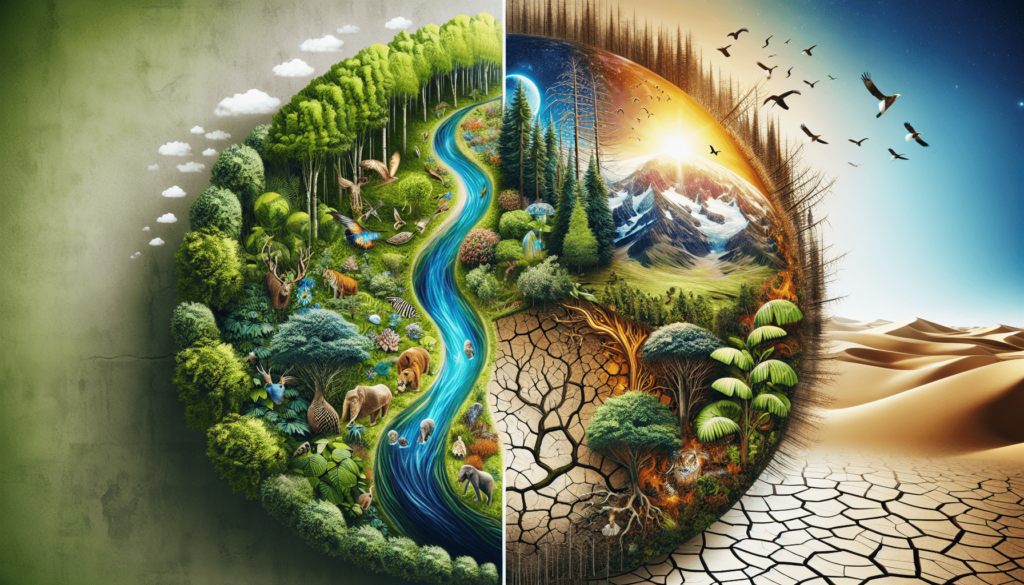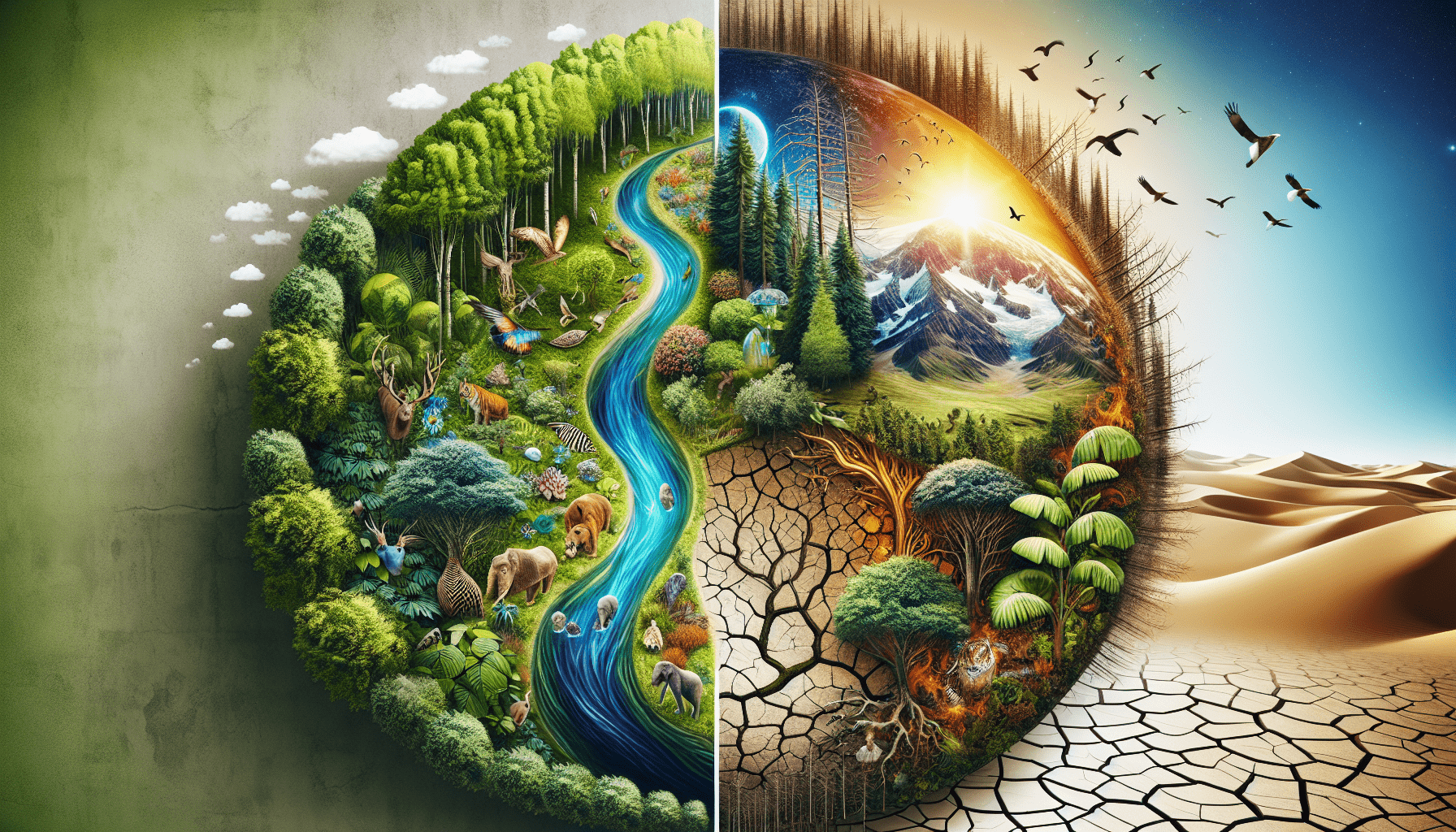In “Understanding The Causes Of Extinction,” you will gain valuable insights into the factors that lead to the disappearance of animal species. This article aims to shed light on the various causes of extinction, allowing you to comprehend the intricate web of environmental, human, and natural factors that adversely affect our planet’s biodiversity. By delving into the complexities of these causes, you will develop a deeper understanding of the urgency behind conservation efforts and the importance of safeguarding our fragile ecosystems.

Habitat Loss
Habitat loss is one of the major causes of extinction worldwide. It refers to the destruction and fragmentation of natural habitats that are vital for the survival of various species. There are several factors contributing to habitat loss, including deforestation, urbanization, and agricultural expansion.
Deforestation
Deforestation is the clearing of forests for various purposes, such as agriculture, logging, and development. This process not only removes the trees themselves but also destroys the intricate ecosystems that rely on them. Deforestation leads to the loss of biodiversity and disrupts the balance of ecosystems, ultimately driving many species to extinction.
Urbanization
Urbanization is the expansion of cities and the conversion of natural habitats into urban areas. As cities grow, they consume more land, leading to the destruction of forests, wetlands, and other habitats. Urbanization not only results in habitat loss but also causes pollution, habitat fragmentation, and the displacement of wildlife. These factors all contribute to the decline of numerous species.
Agricultural Expansion
Agricultural expansion, particularly for crop cultivation and livestock farming, is a significant driver of habitat loss. In order to meet the increasing demand for food, vast areas of land are cleared for agriculture, often leading to the destruction of primary forests and other important habitats. The conversion of natural habitats into agricultural landscapes not only destroys the homes of countless species but also reduces biodiversity and disrupts ecological processes.
Climate Change
Climate change, driven mainly by human activities, poses a significant threat to species worldwide. It leads to changes in temperature, precipitation patterns, and other climatic variables, which can have detrimental effects on various ecosystems and their inhabitants.
Global Warming
Global warming refers to the long-term increase in Earth’s average surface temperature due to greenhouse gas emissions. The burning of fossil fuels, deforestation, and other human activities release greenhouse gases into the atmosphere, trapping heat and causing the planet to warm. Rising temperatures have profound effects on ecosystems, including the melting of polar ice caps, sea-level rise, and shifts in the distribution of species. These changes can disrupt the delicate balance of ecosystems and lead to the extinction of many species.
Ocean Acidification
Ocean acidification is a direct consequence of increased carbon dioxide (CO2) emissions. As the concentration of CO2 in the atmosphere rises, a significant portion is absorbed by the oceans, leading to the acidification of seawater. This process has detrimental effects on marine organisms, such as coral reefs, shellfish, and plankton, which rely on stable pH levels for survival. The acidification of oceans can disrupt marine food chains and ecosystems, ultimately leading to the extinction of various species.
Altered Rainfall Patterns
Climate change is also responsible for altered rainfall patterns, including changes in the timing, intensity, and geographic distribution of rainfall. These alterations can have severe consequences for both terrestrial and aquatic ecosystems. Droughts, floods, and other extreme weather events caused by altered rainfall patterns can lead to habitat destruction, the collapse of food chains, and the displacement of species. These disruptions increase the vulnerability of species to extinction.
Invasive Species
Invasive species are non-native organisms that establish themselves in new environments, often outcompeting and displacing native species. The introduction of invasive species is a major cause of population declines and extinctions worldwide.
Introduction of Non-native Species
The introduction of non-native species can occur through human activities, such as the deliberate release of pets or the accidental transport of organisms via trade and travel. These introduced species often lack natural predators and competitors, allowing them to multiply rapidly and outcompete native species for resources. This can result in the decline or extinction of native species that are unable to adapt to the presence of these invasive species.
Predation and Competition
Invasive species can have direct negative impacts on native species through predation and competition for resources. Invasive predators can decimate native populations, particularly in island ecosystems that evolved in the absence of such predators. Similarly, invasive species that compete with native species for food, habitat, or other resources can place significant pressure on native populations and drive them towards extinction.
Overexploitation
Overexploitation refers to the unsustainable use of natural resources, leading to the depletion and eventual extinction of species. Human activities such as illegal wildlife trade, overfishing, and unregulated hunting contribute to the overexploitation of species worldwide.
Illegal Wildlife Trade
The illegal wildlife trade is a lucrative industry that involves the smuggling and trafficking of endangered species and their products. The demand for exotic pets, traditional medicines, and luxury items drives this trade, putting immense pressure on vulnerable species. Poaching and illegal trade not only have devastating consequences for the targeted species but also disrupt ecosystems and contribute to the decline of other species that depend on them.
Overfishing
Overfishing occurs when fish and other aquatic species are harvested at a rate that exceeds their ability to replenish themselves. Unsustainable fishing practices, such as the use of large-scale nets, dynamite fishing, and bycatch, lead to the depletion of fish stocks and the disruption of marine ecosystems. Overfishing has driven numerous fish species to the brink of extinction, affecting not only the targeted species but also the delicate balance of marine ecosystems.
Unregulated Hunting
Unregulated hunting, particularly of endangered species or animals with valuable parts, has devastating effects on biodiversity. Many species, such as tigers, rhinos, and elephants, are hunted for their skins, bones, and tusks, which are highly valued in illegal markets. This uncontrolled hunting puts immense pressure on vulnerable species and can lead to their extinction. Additionally, the removal of key predators from ecosystems can have cascading effects on other species, disrupting ecological balance.

Pollution
Pollution, in its various forms, poses a significant threat to wildlife and ecosystems. The pollution of air, water, and land can have direct and indirect impacts on species, leading to population decline and extinction.
Air Pollution
Air pollution, primarily caused by human activities such as burning fossil fuels, releases harmful gases and particles into the atmosphere. These pollutants can have detrimental effects on the health of both wildlife and humans. Acid rain, for example, damages forests and aquatic ecosystems, leading to the decline of species. Additionally, air pollution can contaminate habitats and reduce the availability of food and resources, directly impacting the survival of species.
Water Pollution
Water pollution, caused by industrial and agricultural waste, oil spills, and improper disposal of chemicals, has severe consequences for aquatic ecosystems. Pollutants in water bodies can harm marine life, including fish, coral reefs, and other organisms. The contamination of water sources can also lead to the extinction of freshwater species, disrupt food chains, and degrade habitats.
Chemical Contamination
Chemical contamination, including the use of pesticides, herbicides, and heavy metals, has adverse effects on biodiversity. These chemicals can accumulate in the environment, contaminating water, soil, and vegetation. Exposure to toxic substances can harm organisms directly, leading to reduced fertility, developmental abnormalities, and even death. Furthermore, the widespread use of agricultural chemicals can detrimentally impact pollinators, such as bees, which play a crucial role in plant reproduction and ecosystem stability.
Disease and Parasites
The spread of infectious diseases and the introduction of pathogens pose significant threats to species, particularly when they encounter novel diseases for which they have no immunity.
Spread of Infectious Diseases
The spread of infectious diseases among wildlife can have devastating effects on populations and can lead to local extinctions or even species-wide extinctions. Disease transmission can occur through direct contact, contaminated food or water, or through vectors such as mosquitoes and ticks. The introduction of new diseases to a population that lacks immunity can cause rapid and widespread mortality, destabilizing ecosystems and threatening the survival of species.
Introduction of Pathogens
Human activities, such as international trade and travel, can inadvertently introduce pathogens into new environments. Pathogens that are harmless to native species can wreak havoc on populations that have no natural defenses against them. This can lead to outbreaks of diseases that result in the decline or extinction of vulnerable species. Climate change can further exacerbate the spread of diseases by enhancing the range and survival of disease-carrying vectors.
Natural Disasters
Natural disasters, such as floods, storms, earthquakes, and volcanic eruptions, have shaped the Earth’s landscape and ecosystems throughout history. However, human activities can exacerbate the impact of these events and contribute to the extinction of species.
Floods and Storms
Floods and storms can have immediate and dramatic effects on ecosystems. These events can flood and destroy habitats, displace wildlife, and cause significant mortality. The destruction of critical habitats and the disruption of food chains can drive species to extinction, particularly those that are specialized and have limited ability to adapt to rapid changes in their environment.
Earthquakes
Earthquakes, resulting from the movement of tectonic plates beneath the Earth’s surface, can have significant consequences for ecosystems. These events can trigger landslides, alter water courses, and generate tsunamis. The disruption of habitats and physical structures can result in the collapse of ecosystems and the extinction of species that rely on them.
Volcanic Eruptions
Volcanic eruptions, while infrequent, can have catastrophic effects on surrounding ecosystems. The eruption of volcanoes releases ash, gases, and lava, leading to the destruction of habitats and the displacement of species. The ash and gases ejected into the atmosphere can also lead to changes in climate and air quality, further impacting ecosystems. These volcanic disturbances can cause extinctions, particularly in isolated and geographically restricted ecosystems.
Genetic Factors
Genetic factors, including genetic bottlenecks and inbreeding depression, can contribute to population declines and the eventual extinction of species.
Genetic Bottlenecks
Genetic bottlenecks occur when a population is dramatically reduced in size, often due to a catastrophic event or human activity. This reduction in population size results in a loss of genetic diversity, as only a small fraction of the original genetic variation remains. Reduced genetic diversity can increase the susceptibility of populations to diseases, reduce reproductive success, and limit adaptability to changing environmental conditions. Over time, these factors can lead to the extinction of species.
Inbreeding Depression
Inbreeding depression refers to the negative effects that result from mating between closely related individuals within a population. Inbreeding can increase the expression of harmful genetic traits, reduce fertility and survival rates, and decrease the overall fitness of a population. These effects can lead to a further decline in population size and increase the risk of extinction over time.
Human Activities
Human activities, driven by factors such as population growth, industrialization, and infrastructure development, have significant impacts on ecosystems and contribute to species extinction.
Population Growth
The growth of the human population puts increasing demands on natural resources, leading to habitat destruction, pollution, overexploitation, and other threats to biodiversity. As the global population continues to grow, so does the pressure on ecosystems and the likelihood of species extinction.
Industrialization
Industrialization, driven by the need for economic growth, often results in the degradation of ecosystems and the disruption of ecological processes. Pollution from industrial activities, habitat destruction due to infrastructure development, and the release of greenhouse gases all contribute to the decline of species. The expansion of industry and the associated increased consumption of resources exacerbate the extinction crisis.
Infrastructure Development
The development of infrastructure, such as roads, buildings, and dams, often leads to the destruction and fragmentation of habitats. Large-scale infrastructure projects can result in the displacement of wildlife, the loss of connectivity between habitats, and the disruption of migration routes. These changes can isolate populations, reduce gene flow, and increase the vulnerability of species to extinction.
Lack of Conservation Efforts
Inadequate conservation efforts contribute significantly to the ongoing extinction crisis. Weak legal frameworks, insufficient funding, and a lack of awareness and education all hinder effective conservation measures.
Weak Legal Frameworks
Many countries lack robust laws and regulations to protect endangered species and their habitats. Weak legal frameworks make it difficult to enforce conservation measures and prosecute those who engage in activities harmful to biodiversity. The absence of effective legislation allows unsustainable practices to continue, contributing to the ongoing loss of species.
Insufficient Funding
Conservation efforts require significant financial resources to be effective. However, funding for conservation initiatives is often insufficient, particularly in the face of other pressing challenges such as poverty and healthcare. Limited resources for conservation hinder the implementation of necessary measures to protect species and their habitats, leaving them vulnerable to extinction.
Lack of Awareness and Education
A lack of awareness and education about the importance of biodiversity and the threats facing species contributes to the ongoing extinction crisis. Many people are unaware of the impact their actions have on ecosystems and the need for conservation. Effective education and outreach programs are essential in promoting a greater understanding of the value of biodiversity and fostering a sense of responsibility towards its protection.
In conclusion, a combination of factors is driving the ongoing extinction crisis. Habitat loss, climate change, invasive species, overexploitation, pollution, disease and parasites, natural disasters, genetic factors, human activities, and the lack of conservation efforts all play significant roles in the declining populations and eventual extinction of species. Addressing these factors requires a holistic and collaborative approach, involving governments, organizations, communities, and individuals. It is crucial to prioritize conservation efforts, strengthen legal frameworks, increase funding, raise awareness, and promote sustainable practices to protect the biodiversity upon which our planet depends. By taking concrete action now, we can mitigate the impact of human activities and provide a future for the countless species that share our planet.

